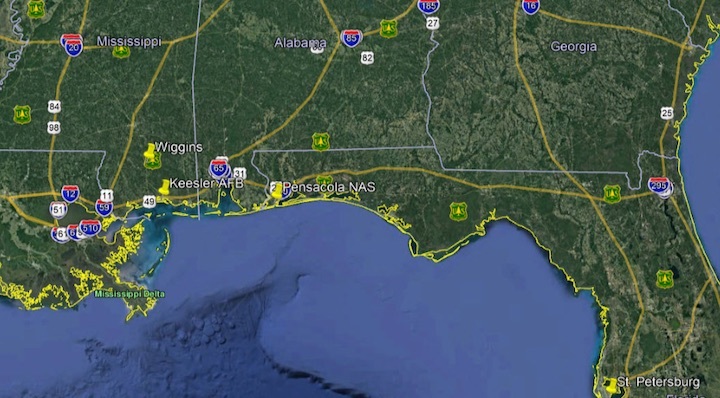
The 701 Club: Case 9345 April 4, 1965 Keesler AFB Mississippi
Don Berlinner lists the case as follows:
April 4, 1965; Keesler AFB, Mississippi. 4:05 a.m. Witnesses: USAF A/2c Corum, a weather observer; confirmation by college student R. Pittman not clear from available data. One 40’ black, oval object with four lights along the bottom, flew in and out of the clouds for 15 seconds.1
Sparks’ entry repeats what Berlinner wrote. He mentions possible radar contact in his table2 but I could not find any mention of radar.
The Blue Book file
Surprisingly, the case file has more than a simple message. The summary mentions that the witness originally only saw four lights. It was only when the object came close to him did he notice a dark object behind the lights. The object went from Southwest to Northeast. There was no sound or trail. There was a cloud layer at 1200 feet and the object was below this. In the original transmit- ted message, it states, “In & out of bases of clouds at 1200 feet”.3
The “confirmation” is also included in the file but there seems to be problems with this. The time listed is two hours before the sight- ing (0805Z vs 1005Z) and it was in the area of Wiggens, Mississippi about 30 miles to the North-Northwest. This was visible for five minutes and traveled towards the South-Southeast.4
There was also a sighting mentioned about 0930Z in Pensacola (about 100 miles to the east) by two air cadets. They reported seeing a ball of flame from which two objects emerged. 5
Dr. Hynek became involved and interviewed the witness. The witness mentioned the object disappeared into the clouds. Apparent- ly, Dr. Hynek ran a time study and determined the duration of observation was 17 seconds.6 However, the witness in the interview stated it only lasted 5-10 seconds. The witness also mentioned that the clouds at 1200 feet were probably the only layer because he could also see stars “sometimes”.
There were several case files from the night. They were the Keesler sighting, the Wiggens sighting, and a sighting from St. Peters- burg, Florida.7 The St Petersburg sighting was at 0800Z. It lasted 15 seconds and Blue Book listed this as a rocket body decay. The direction from Northwest to Southeast. Ted Molczan’s database indicates there was a decay on that date but it was 15 hours later at 2324Z. 8
Analysis
There is a lot of interesting coincidences here. First of all the 0800Z sighting at Wiggens and St. Petersburg were probably related since they were at approximately the same time and the same direction. However, there was no re-entry and it seems this was nothing more than a fragmenting meteor. One has to wonder if these sightings were related to the Keesler event. The direction was wrong compared to the other sightings and the time was different by two hours so it seems unlikely.

This brings up the other sighting that night mentioned in the message traffic thirty-five minutes prior to the sighting. The Keesler sighting mentioned the time was approximately 0405 CST. The Pensacola sighting time could also have been inaccurate. Looking at the American Meteor Society’s database of fireballs, variations in time can be as much as an hour or more. Therefore, this is not an unrealistic assumption. If these two sightings were of the same object, then it was much higher than 1200 feet since it could be seen from two locations so far apart.
Weather underground states the weather observations that morning varied from cloudy to partly cloudy. The observation at 0400 was partly cloudy.9 Pensacola had no observation for 4AM but the 3AM observation was partly cloudy.10 This tends to confirm what the witness stated in that it was not completely overcast and some stars were visible.
The possibility that a bright meteor could have been misinterpreted as a dark object with lights needs to be considered. The Zond IV event, as well as others, demonstrate that witnesses can, and do, perceive a group of individual lights as being connected to a larger object.
Conclusion
In my opinion, it is plausible that this was an observation of a bright fireball visible passing between and visible through thin clouds. The witness admitted, and weather records support, the fact the sky was not completely overcast. The fact that bright me- teors can be visible under such conditions is documented.11,12 As a result, this sighting should be reclassified as a “possible meteor”.
Quelle: SUNlite 2/2019
